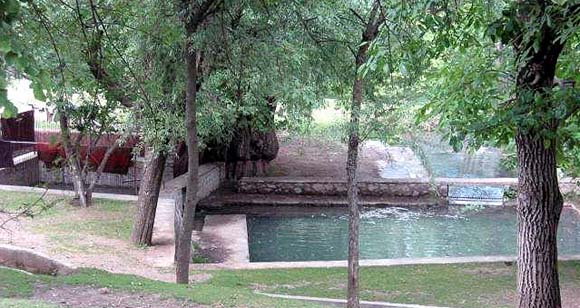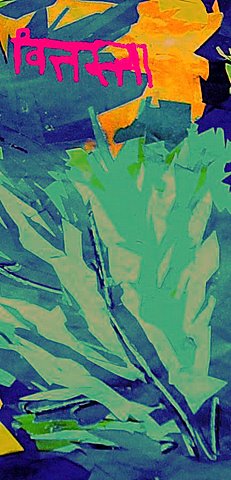VITASTA The Vyeth of Kashmir
| | ||||||
|
*Chaman Lal Raina
| ||||||

yāni tīrthāni bhāratavarṣe tāni tīrthāni kāśmīra maṇḍale| yani tīrthani kāśmīra maṇḍale tāni tīrthani vitastāyam||
The Bhadra Shukla Trayodashi, or Vyatha Truvah, which is the 13th lunar digital day of the month of Bhadra-Pada, generally falls in the month of August or September.This is the very auspicious day for the people of Kashmir, because the Vyeth got incarnated that very day and its constant flow speaks of its grandeur from Vetra Vatti, which is Vyeth –Vottur, in the Kashmiri ethos. The Vetra Vatti is one of the forms of Bhavani---the Divine Mother Parvati, as explained by Shiva to his disciple Nandi , in the Rudyamala Tantra. Glory of the Divine Mother is fully explained with reference to the Primordial nature of the Absolute, in the Bhavani Sahsranama.Lord Shiva has explained the Thousand Names of Parvati, who is "Shaila Putri-- Parvati" as well. Much water has flown from the river Vitasta, since it got incarnated on the Reshi Vai’r of Kashmir. Rrshi Vair is the Apbhramsha of the Sanskrit word Rishi Vatika'which means the playground for the Rishis--the seers of the Vedic truth..We as the Hindus of Kashmir have special reverence for this sacred river. Hindus would offer their Sandhya on its banks at the --early dawn, followed by the The place at the Ganpatyar temple is revered as to be the important Tirtha of Kashmir, because Ganesha is the dearest son of the Divine Mother Parvati, as she incarnated in the form of the river Vitasta. Says Vaishampaayana in the 12th Shloka of the Nilamata Purana: Devi Uma is the same as Kashmira,.What was previously, an enjoyableand heart captivating lake became a beautiful valley. 
yaiva devī umā saiva kaśmīrā nṛpasattama| sīt saraḥ pūrṇajalam suramyaṁ sumanoharaṁ|| further, Vaishampayan explains the beauty of Kashmir as under:-- 
kaśmīrāmaṇḍalaṁ puṇyaṁ sarvatirtha mandiram| tatra nāgahṛdāḥ punyāstatra punyāḥśiloccyāḥ|| tatyra nadyastathā puṇyāni ca sarāṁsyapi| devālayā mahāpuṇyāsteśāṁcaiva tathāśramāh||
The translation runs as:-- The holy place of Kashmiris filled with the sacred spots. The sacred lakes of the Nagas are in plenty there and are the holy mountains. Of course, there are sacred rivers, sacred lakes, sacred templesand also the hermitages on that sacred land. That is why all the major temples are situated on the banks of the river Vitasta--the Vyeth of Kashmir. Close to Ganapat Yaar on the banks of the river is the Bhagvan Gopi Nath’s Ashram known as the Vaihkuri Yaar or the Kharyaar. It is because of the linguistic changes, as we see in the Apbhramsha, Vaikhuri Yaar has become the Khar Yaar. This was a center of Sadhana for thousands of people. Soomyaar/Somyaar is considered as the important Tirtha for the Kashmiri Hindu women. This Tiratha--pilgrimage on the banks of the Vyeth is at the Habba Kadal bridge. This Tiratha is associated with the Somavati Amavasya. When the SOMVAAR or Monday coincides with the Amavasya or No-Moon day, it is called the Somavati Amavasya. The women take the dip in the Vitasta early in the dawn for being Suhagin. Suhagin is the symbol of auspiciousness for a women. On the opposite bank of the river, there is Purusha Yaar, which speaks of the dedication towards the Vedic Purusha Sukta , followed by Drabi Yaar temple. Famous temple Raghu Nath Mandir is situated on the bank of the Vyeth in the Fateh Kadal area. Next comes the famous TRIKA Ashram at Fateh Kadal area, close to the Spring of Mahakali, which is very sacred for the Hindus. Mahakali is the Ishta Devi of many Kashmiri Pandit families. Devotees going for a Parikrama--cirmumambulation to the Hari Parbat and the Chakreshwara would pay their Pranams and obeisance to the flow of the mystic spring. Then they would move for the Parikrama. The devotees would recite the following Shloka on the banks of the river facing towards the Sindoori Darbar of the Mahakali shrine. 
māyā kuṇḍalinī kriyā madhumatī kāli kalā mālinī mātaṁgī vijayaa jaya bhagavatī devī śivā śambhavī aktiḥ śaṁkaravallabhā trinayanā vāgvādinī bhairavī hrīṁkārī tripurā parāparamayī mātā kumārītyasi This Shloka is the quintessence of the Kashmir Shakta Vimarsha, as explained in the Agamic literature. Shri Mahakali is the Timelessness of the universe. what a wonderful explanation of the Mahakali. She is both present in the serial time of the universe and beyond that. Then is the famous temple of Zaina Kadal Next is the Siddha Pitha of Peer Pandit Patshah Rishi Peer Sai’b, who brought the Hara Mukuta Ganga manifested on the banks of Bhat Yaar itself. A temple is situated on the Batyar itself. The Pandits lived in the consolidated position, by the efforts of Pandit Shri Bhat on both sides of the river Vitasta, after they were settled after the great fire of that area. Shri Bhatt of the Vichar Nag area was responsible for bringing back the displaced Pandits to Kashmir, in the reign of Budshah. Thus developed the Bhanumaasi and Malamasi system of the society. Mostly, Pundits of that time preferred to reside on the banks of the river Vitasta and other sides, where water was in natural flow. They settled mostly on the banks of the river Vitasta, in the capital city of Srinagar. Some took their residence in the villages of the southern and northern Kashmir. A very important Tiratha in the Anant Nag area is the Vijayeshvar on the banks of the Vitasta. It has remained the center of astrology. Lall Trag is in the Pampore area is associated with Lallesheshvai-the Lall Ded of the 14th century. Then no significant Tiratha has come to my notice, as I had not the opportunity to visit the other Tirthas on the banks of the Vyeth. But the Prayag at Shadipur is considered one of the important Tiratha. It is the Sangam / circumfluence of Vitasta and Sindhu/ Nalla Sind at the Prayag . Remains of the ashes of the Kashmiri Hindus were being immersed in the Sangam or Prayag upto 1989, till the mass migration of the Kashmiri Pandits took place. Next comes the Tapasya Bhumi of Mata Roopa Bhavani, revered as the Alakheshvari, which is known as Waskoora.It is also close to the bank of the Vyeth. Then the great Tiratha of Nandakeshwara is situated on the banks of the Vyeth at Sumbal. Many more temples do exit on the banks of the river Vitasta, but I have covered a few of the Tirathas, on the bank of the river Vyeth, personally gone, visited there and paid my oblations to the Devatas and Rishis of Kashmir.A very spiritual flow on the banks of the river Vitasta was witnessed by one and all. One of the names of the Bhavani is Vitasta, and in every Homa/ Havana , Kashmiri Pandit offers Ahuti to the Vitasta, in the form of Vyeth. In every Prepyuna or offering, the Naveed is offered to the Vitasta, even after the 1990 migration. It is linked with our religious psyche. How was Vyetha Truvah observed? The Kashmiri Pandits would go to their respective Ghaths and would offer water to the sacred river Vitasta. They would offer Tomlu- Tsochi Worya or the bread made from the rice flour to the Vitasta as an offering and would read the Shlokas from the Vitasta Mahatmyam. In the evening, the Hindu women would go and offer Tsong, which is earthen lamp/ Diya or Deepak to the river and would keep the Tsong lit to illumine the banks of Vitasta.Vyeth is the life-breath of the Kashmiri Pandit ethos. We love her as we love our mother. How can we forget her ?. She is not mere water resource, but she is inspiration to live a Kashmiri way of life. In all her acts, a strange Divinity of Vitasta welcomed with a smile, when our ancestors were called back with the great efforts of Shri Bhat. . What is now? We do not know----. A big question mark?. We can not go. But Vitasta is in our dreams of delight, in our wakeful thoughts. and in our spiritual environment. Even here ,we need to celebrate the Divinity of the Vitasta. She is still to them, the child they new and loved The sorrowing Vyeth, we feel within our throbs” Kashmiri Pandit is closely associates with the Vitasta, as the Nirmalya was supposed to be disposed off as an oblation in the Vitasta. All the tenth day Kriya was necessarily to be done on the banks of the River Vitasta. We find our cultural roots in the Vitasta. This Vyeth is known officially as the river Jehlum. How it got the name Jehlum is the subject of research for the historians. The flow of Vitasta acts, but it is sealed for us, On her body is played now the Tandava dance. | ||||||
| | ||||||
| | ||||||

*Dr. Chaman Lal Raina did Masters in Hindi & English. Ph.D. in Hindi & Iqbaliat at the University of Kashmir. Worked on the research project at the Iqbal Institute for writing monographs on Indology as Research Associate. Worked as lecturer to teach research methodology in Iqbal Institute, University of Kashmir. Dr. Raina's first love is for the Vedas and the Shakti Tradition of India. To his credit goes some ten books on Indology. He was awarded Nagmani Fellowship, Buddhist Fellowship etc. from various Institutions. Presently Dr. Raina is associated with the Yoga Studies, religion and sanskrit at Florida International University, USA. | ||||||
| | ||||||
| Copyrights © 2007
Shehjar online
and
KashmirGroup.com
. Any content, including but not limited to text, software, music,
sound, photographs, video, graphics or other material contained may not
be modified, copied, reproduced, republished, uploaded, posted, or
distributed in any form or context without written permission.
Terms & Conditions.
The views expressed are solely the author's and not necessarily the views of Shehjar or its owners. Content and posts from such authors are provided "AS IS", with no warranties, and confer no rights. The material and information provided iare for general information only and should not, in any respect, be relied on as professional advice. Neither Shehjar.kashmirgroup.com nor kashmirgroup.com represent or endorse the accuracy or reliability of any advice, opinion, statement, or other information displayed, uploaded, or distributed through the Service by any user, information provider or any other person or entity. You acknowledge that any reliance upon any such opinion, advice, statement, memorandum, or information shall be at your sole risk. | ||||||





No comments:
Post a Comment